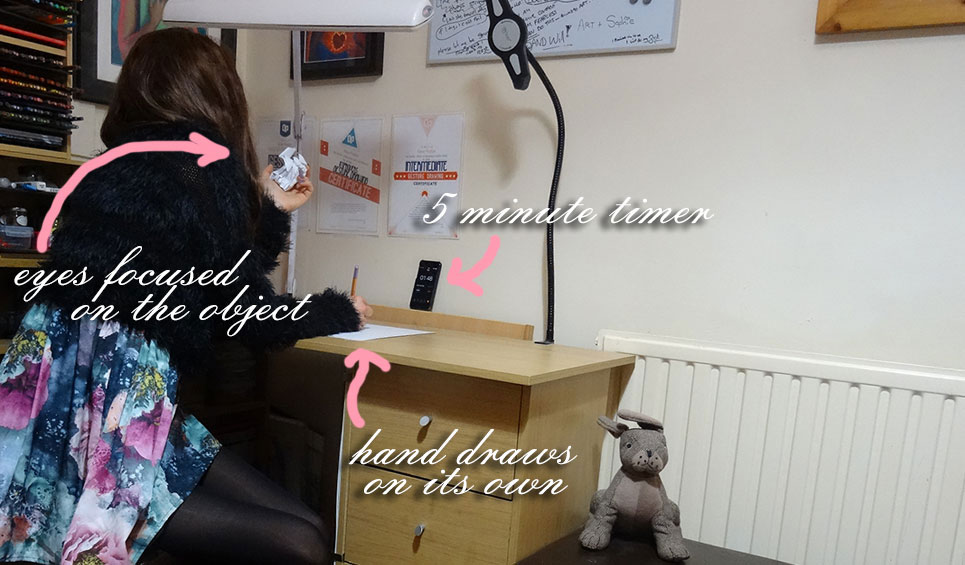
#Blind contour drawing exercises how to
Though I will say, it’s a good way to loosen up your hand before you being ‘properly’ drawing.Do you ever get your sketchbook out, or set up your whole workspace to draw, only to find yourself paralyzed by how to start? You sit there, staring at the blank canvas, twiddling your thumbs, racking your brain for ideas good enough to make the first mark. I don’t feel I get a lot out of it as I’m already using the process and have learned a great deal from how it can improve my drawing skills, and I find it much less enjoyable than rapid sketching or single-line drawings. There were a few times I slipped up and looked at my page, but I still felt like I was appropriately carrying out blind contour drawings.Īs I already use this technique when building up my sketches into finished illustrations, I can’t imagine I will ever consciously choose to sit down and complete a page of ‘fully blind contour drawings’. I tried to find a way to actually cover my hand so that I couldn’t see what I was doing, but there wasn’t a practical solution. My finished pages with the fully-blind drawings added inĭespite my experience, I struggled with the fully blind contour drawings at first, as I am so used to glancing quickly and sporadically at my page. Choosing animals as my subject matter has allowed room for a lot of character to develop, and I feel I could further develop these sketches to give them even more personality.

I really enjoy how all of the drawings turned out, even the messy ones. This was tricky and was almost like combining one-line drawings with blind contour drawings. As recommended in the exercise, I tried not to take my pen off the page as much as possible whilst studying my reference. This way, I could let them overlap but still be distinct from each other. I chose to do my semi-blind contour drawings using a green brush pen and my fully blind contour drawings using a 1.0 black fineliner. This exercise, then, felt a bit like doing something for the sake of saying I had done it, and I wasn’t super excited about that. When I draw now, I pretty much always start with a semi-blind contour sketch, then build up from there. Looking at the paper would simply trick me into thinking I knew better than what my eyes could see. As a child, my grandad taught me to never take my eyes off the subject I was drawing. I ended up choosing a range of animals as I enjoy drawing them and haven’t done so in quite a while.īlind contour drawings are a concept I have been aware of for almost as long as I have been able to draw. I wanted to use Pinterest for this exercise to find material to reference but was overwhelmed by options. But, I am starting to find myself quite bored with drawing the same things on my desk over and over again. I know a lot of these exercises are about exploring processes and not as much about the content you choose to study, and I’m also aware that drawing anything and everything is beneficial. For the other exercises, I decided to use the A6 travel sketchbook I have half-finished, as I want to fill it up completely.Īnother issue I am having is figuring out what to draw. As the paper in the original sketchbook was specifically chosen to withstand wet media and experimentation, I opted to reserve it for the exercises and tasks that required it. I spent some time deliberating over what to do about this, whether to make a second book, just work on scrap paper and add it in somehow, or use another sketchbook.

I miscalculated my pages a little and somehow forgot that two of the exercises existed, so I am close to running out of room.

I have run into an issue with the sketchbook I am using for this part of the unit. I had to draw at least three semi-blind contour drawings – where I was allowed to occasionally look at the page – and at least four totally blind contour drawings. It is named as such as drawing in this manner usually means you only draw the outline, or contour, of the scene you are drawing. This, essentially, consists of drawing without looking at the page. In this exercise, I was asked to try my hand at blind contour drawings.


 0 kommentar(er)
0 kommentar(er)
